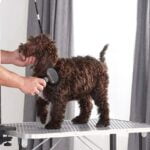Table of Contents
Accidents and emergencies can happen at any time, and being prepared with the right pet first aid tips can make a significant difference in your pet’s health and safety. In this article, we provide 10 essential pet first aid tips to help you handle common pet emergencies effectively.

1. Keep a Pet First Aid Kit
Having a well-stocked first aid kit is crucial for managing minor injuries and stabilizing your pet during emergencies. Your kit should include bandages, antiseptic wipes, tweezers, a digital thermometer, and a pet-safe first aid manual. For a comprehensive list of items, visit ASPCA First Aid Kit.
2. Know Basic Pet CPR
Learning how to perform CPR on your pet can save their life in critical situations. Familiarize yourself with the steps for pet CPR, including chest compressions and rescue breaths. For detailed instructions, see Red Cross Pet CPR.
3. Handle Wounds and Bleeding
For minor cuts and wounds, clean the area with antiseptic and apply a bandage. If your pet is bleeding heavily, apply pressure with a clean cloth and seek veterinary assistance immediately. For more on wound care, visit PetMD Wound Care.
4. Manage Choking Incidents
If your pet is choking, carefully open their mouth and try to remove the obstruction with tweezers. Be cautious to avoid pushing the object further down. If you cannot remove it, perform the Heimlich maneuver for pets. For more on managing choking, visit Cornell Vet First Aid.
5. Treat Burns and Scalds
For minor burns, cool the area with cold water and apply a pet-safe burn ointment. Do not use ice or ice-cold water, as this can cause further tissue damage. Seek veterinary care for severe burns. For more on treating burns, see PetMD First Aid for Burns.
6. Address Poisoning
If you suspect your pet has ingested a toxic substance, contact your veterinarian or a pet poison control center immediately. Do not induce vomiting unless directed by a professional. For more on poisoning, visit ASPCA Animal Poison Control.
7. Stabilize Fractures and Sprains
If your pet has a suspected fracture or sprain, keep them as still and comfortable as possible. Apply a cold compress to reduce swelling and seek veterinary assistance. Avoid trying to set the bone yourself. For more on handling fractures, visit Vets Now Fracture Care.
8. Recognize Signs of Heatstroke
Heatstroke is a serious condition that can occur if your pet overheats. Signs include excessive panting, drooling, and lethargy. Move your pet to a cool area, offer water, and cool them with damp towels. Seek veterinary care immediately. For more on heatstroke, visit AKC Heatstroke Prevention.
9. Handle Seizures Safely
If your pet experiences a seizure, do not try to restrain them. Move any objects away that could cause injury and time the seizure. Keep your pet cool and calm, and contact your veterinarian once the seizure subsides. For more on managing seizures, see PetMD Seizure Management.
10. Know When to Seek Veterinary Help
In any emergency, knowing when to seek professional help is crucial. If your pet shows signs of severe injury, illness, or distress, contact your veterinarian or an emergency animal hospital immediately. For more on recognizing emergencies, visit AVMA Emergency Preparedness.
Conclusion
Being prepared with these essential pet first aid tips can make a significant difference in your pet’s health and safety during emergencies. By keeping a well-stocked first aid kit, knowing basic CPR, and recognizing signs of common issues, you can provide effective care when your pet needs it most. For more comprehensive information on pet first aid tips and pet care, check out our Pet Care Guide.
FAQs on Pet First Aid Tips
What should I include in a pet first aid kit?
Include bandages, antiseptic wipes, tweezers, a digital thermometer, a pet-safe first aid manual, and any specific items your pet may need.
How do I perform CPR on my pet?
Pet CPR involves chest compressions and rescue breaths. Learn the specific steps for your pet’s size and consult resources like the Red Cross Pet CPR guide.
What are the signs of poisoning in pets?
Signs include vomiting, diarrhea, drooling, tremors, and seizures. Contact your veterinarian or a pet poison control center immediately if you suspect poisoning.
How can I prevent heatstroke in my pet?
Ensure your pet has access to shade and water, avoid exercising them in hot weather, and never leave them in a parked car.
What should I do if my pet has a seizure?
Do not restrain your pet. Move objects away to prevent injury, time the seizure, and contact your veterinarian once it subsides.
When should I seek veterinary help for my pet?
Seek professional help if your pet shows signs of severe injury, illness, or distress, or if you are unsure how to handle an emergency situation.











